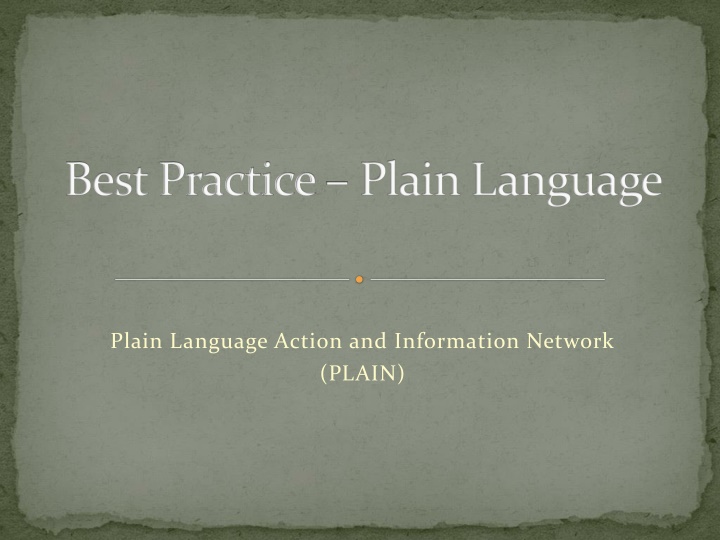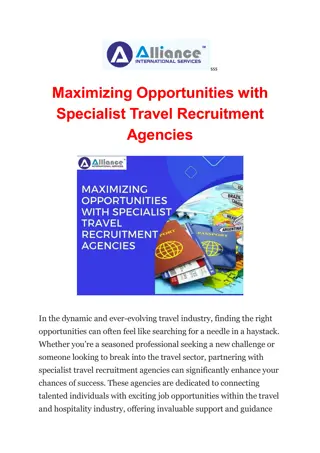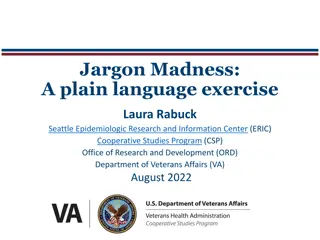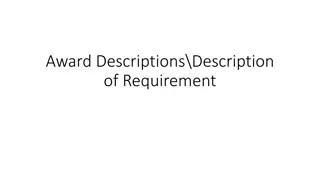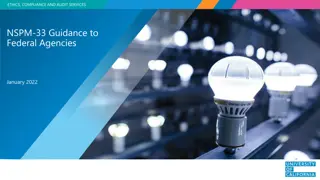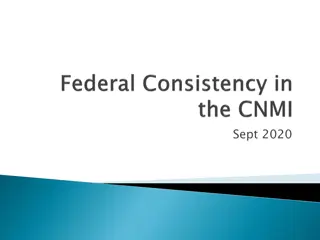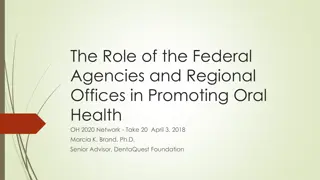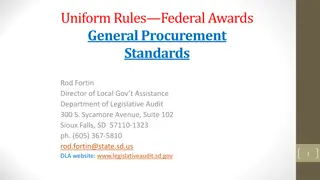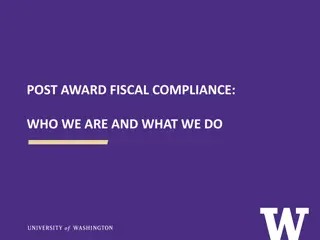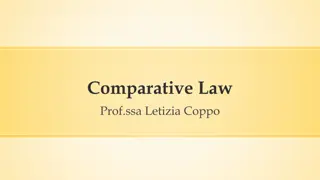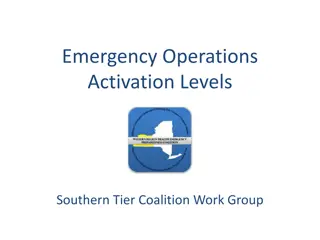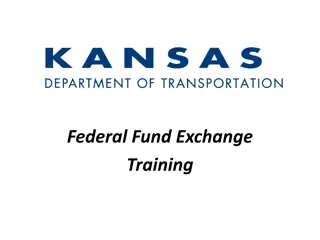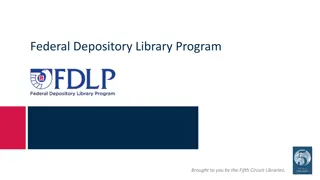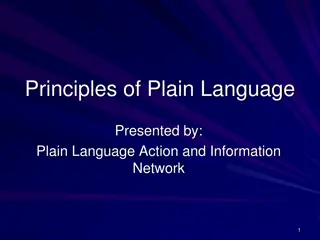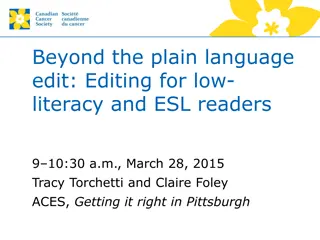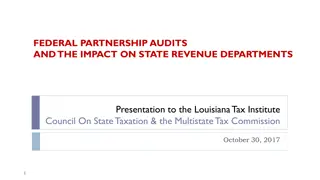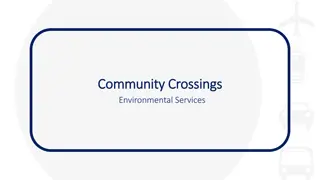Plain Language in Federal Agencies: Compliance and Implementation
The Plain Writing Act of 2010 mandates federal agencies to communicate clearly with the public in documents related to benefits, services, and compliance. This act sets deadlines for agencies to designate officials, train staff, use plain language, and report compliance. The Act does not cover regulations but aligns with Executive Orders emphasizing plain language in regulatory practices. Initiating a Plain Language Program involves setting SMART goals, ensuring organizational understanding, addressing key issues, and striving for continual improvement.
Download Presentation

Please find below an Image/Link to download the presentation.
The content on the website is provided AS IS for your information and personal use only. It may not be sold, licensed, or shared on other websites without obtaining consent from the author.If you encounter any issues during the download, it is possible that the publisher has removed the file from their server.
You are allowed to download the files provided on this website for personal or commercial use, subject to the condition that they are used lawfully. All files are the property of their respective owners.
The content on the website is provided AS IS for your information and personal use only. It may not be sold, licensed, or shared on other websites without obtaining consent from the author.
E N D
Presentation Transcript
Best Practice Plain Language Plain Language Action and Information Network (PLAIN)
Plain Writing Act of 2010 Act requires federal agencies to use clear communication that the public can understand. Included are documents that: Are needed to get federal benefits or services or for filing taxes Provide information about benefits or services Explain how to comply with requirements administered or enforced by the federal government
Plain Writing Act of 2010 On April 13, 2011 OMB must: Issue final guidance for the Act.
Plain Writing Act of 2010 By July 13, 2011 agencies must: Designate a senior official for "plain writing" Explain and train agency staff on the Act Set up a procedure to oversee implementation of the Act Have agency points of contact for the Act Post compliance plans on line
Plain Writing Act of 2010 Starting October 13, 2011 agencies must: Use plain language in any new or substantially revised document Write annual compliance reports and post these reports on its plain language web page
Regulations The Act does not cover regulations The following Executive Orders emphasize the need for plain language in regulations: E.O. 13563 Improving Regulation and Regulatory Review E.O. 12866 Regulatory Planning and Review E.O. 12988 Civil Justice Reform Best Practices for Federal Agencies
Starting a Plain Language Program Make it SMART: Specific Measurable Achievable Realistic have a Timeframe
Define Goals Clearly Make sure your organization: Understands what Plain Language is Is on the same page: 1 training program for the entire organization Identifies key pain points and works to improve those documents first Looks for small successes and aim for continuous improvements
High Level Support Your program will fail without top level support! Your senior managers need to be plain language champions Have top level messages promote plain language Encourage managers to attend plain language class Have regular meetings to brief management on your program
Program Tips Have training classes often (once a month or once a quarter) Offer class to HQ and the field Send broadcast messages to remind employees about the importance of clear writing Create an electronic writing guide accessible to workforce Make educational videos Create a recognition program
Key Plain Language Techniques Identify and Write for Your Audience Use Active Voice Keep paragraphs and sentences short Limit jargon, legalese and acronyms
Writing for your audience Put yourself in your reader s shoes Who is my audience? What does my audience need to know? What does my audience already know about the subject? What questions will my audience have?
Active Voice Be transparent! Show who or what is doing the action upfront. Instead of: New regulations were proposed. Use: The Department of Transportation proposed new regulations.
Active Voice (cont) Active Voice: Eliminates ambiguity: Passive: It must be done. Active: You must do it. Emphasizes important messages Passive: O-ring temperature will be achieved at 32 degrees Active: The O-rings will fail at 32 degrees.
Keep it short With respect to the review of existing regulations and the promulgation of new regulations, section 3(a) of Executive Order 12988, Civil Justice Reform, 61 FR 4729 (February 7, 1996), imposes on Executive agencies the general duty to adhere to the following requirements: (1) Eliminate drafting errors and ambiguity; (2) write regulations to minimize litigation; and (3) provide a clear legal standard for affected conduct rather than a general standard and promote simplification and burden reduction. With regard to the review required by section 3(a), section 3(b) of Executive Order 12988 specifically requires that Executive agencies make every reasonable effort to ensure that the regulation: (1) Clearly specifies the preemptive effect, if any; (2) clearly specifies any effect on existing Federal law or regulation; (3) provides a clear legal standard for affected conduct while promoting simplification and burden reduction; (4) specifies the retroactive effect, if any; (5) adequately defines key terms; and (6) addresses other important issues affecting clarity and general draftsmanship under any guidelines issued by the Attorney General. Section 3(c) of Executive Order 12988 requires Executive agencies to review regulations in light of applicable standards in section 3(a) and section 3(b) to determine whether they are met or it is unreasonable to meet one or more of them. DHS has completed the required review and determined that, to the extent permitted by law, this final rule meets the relevant standards of Executive Order 12988.
Keep it short This rule meets the applicable standards in sections 3(a) and 3(b)(2) of Executive Order 12988. The most valuable of all talents is never using two words when one will do. ~Thomas Jefferson
Jargon and acronyms Avoid obscure and archaic language Example: Hereby, Wherefore, ab initio Use language your audience is familiar with Instead of: The patient is being given positive-pressure ventilatory support. Use: The patient is on a respirator. Define your acronyms You may use your Transportation Worker Identification Credential (TWIC) at airport checkpoints.
Resources PLAIN monthly meetings Held the 2nd Wednesday of each month. PLAIN s website: www.plainlanguage.gov Federal Plain Language Guidelines. http://www.plainlanguage.gov/howto/guidelines/bigdo c/index.cfm
Resources PLAIN offers free, half day training to all federal agencies. Provide us with: A few tentative dates for class Location of training Number of students (We prefer 20 or more) You can have your trainers take the class and develop an agency specific training class based on our class.
Additional resources GSA Webcontent Managers are developing plain language webinars NIH has an online plain language course open to the public FAA Plain Language program USCIS Plain Language program SEC Plain English Initiative
